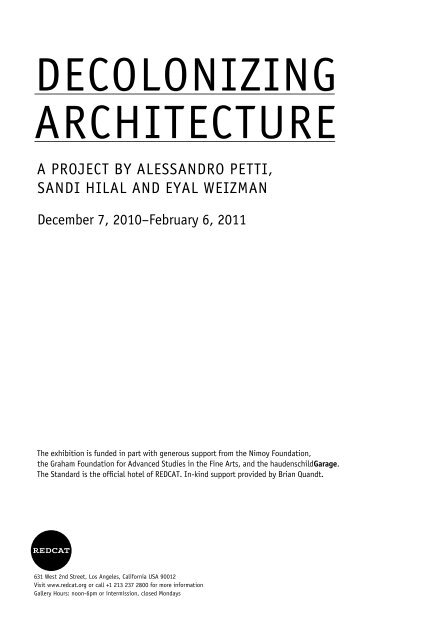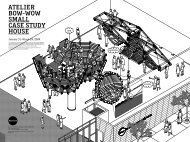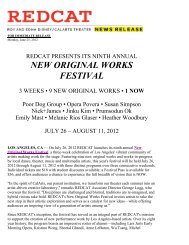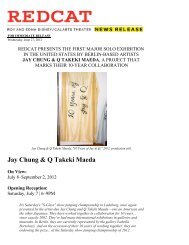A projeCt by ALeSSAnDro petti, SAnDi HiLAL AnD eyAL ... - Redcat
A projeCt by ALeSSAnDro petti, SAnDi HiLAL AnD eyAL ... - Redcat
A projeCt by ALeSSAnDro petti, SAnDi HiLAL AnD eyAL ... - Redcat
Create successful ePaper yourself
Turn your PDF publications into a flip-book with our unique Google optimized e-Paper software.
DeCoLonizinG<br />
ArCHiteCtUre<br />
A <strong>projeCt</strong> <strong>by</strong> <strong>ALeSS<strong>AnD</strong>ro</strong> <strong>petti</strong>,<br />
<strong>S<strong>AnD</strong>i</strong> <strong>HiLAL</strong> <strong>AnD</strong> <strong>eyAL</strong> WeizMAn<br />
December 7, 2010–February 6, 2011<br />
the exhibition is funded in part with generous support from the nimoy Foundation,<br />
the Graham Foundation for Advanced Studies in the Fine Arts, and the haudenschildGarage.<br />
The Standard is the official hotel of REDCAT. In-kind support provided <strong>by</strong> Brian Quandt.<br />
631 West 2nd Street, Los Angeles, California USA 90012<br />
Visit www.redcat.org or call +1 213 237 2800 for more information<br />
Gallery Hours: noon-6pm or intermission, closed Mondays
the exhibition centers on three projects <strong>by</strong> Decolonizing Architecture/<br />
Art residency (DAAr), a bethlehem based studio led <strong>by</strong> Alessandro <strong>petti</strong>,<br />
Sandi Hilal and eyal Weizman.<br />
DAAR has been in recent years engaged in a series of projects that seek to<br />
use spatial practice as a form of political intervention and narration.<br />
DAAR’s work does not start from a utopian image but rather from what<br />
already exists.<br />
probing politics through architectural interventions and mobilizing<br />
architecture politically, it proposes the subversion, reuse, profanation and<br />
recycling of the existing infrastructure of a colonial occupation. it employs<br />
political, legal and architectural approaches in beginning to articulate the<br />
contours of a “detoured” world in which all physical and organizational<br />
structures are reused, but not in the way they were originally designed for.<br />
With the possibility of significant transformation blocked <strong>by</strong> the political<br />
impasse otherwise known as the “peace process,” one of the challenges of<br />
the project is to test out the ways in which architecture can function as<br />
an “arena of speculation” about different future scenarios for palestine, as<br />
evidence or as legal claim.<br />
DAAr is directed <strong>by</strong> Alessandro <strong>petti</strong> and was originally conceptualized and its pilot stage produced in dialogue<br />
with eloisa Haudenschild and Steve Fagin, partners in the haudenschildGarage, Spare parts projects.<br />
www.decolonizing.ps<br />
HoW to inHAbit tHe HoUSe oF yoUr eneMy?<br />
Historical processes of decolonization tended to see the reuse<br />
of the buildings and infrastructure left behind in the same way<br />
they were designed for, leaving some of the power hierarchies<br />
of the colonial world intact.<br />
This project deals with the one of the most difficult questions of<br />
decolonization: how to inhabit the colonies and military bases<br />
to be evacuated in the future archaeology of israel’s occupation?<br />
Concentrating on the settlement of psagot near ramallah,<br />
the guiding principle was not to eliminate the power of<br />
the occupation’s built spaces, nor simply to reuse it in the<br />
way it was designed for, but rather to reorient its logic to<br />
other aims.<br />
Psagot, like other settlements, is suburban when thought of<br />
in relation to the jewish geography in the occupied territories.<br />
these settlements are fenced up bedroom communities fed <strong>by</strong> a<br />
growing matrix of roads and other infrastructure, but they must<br />
be articulated as potentially urban when considered in relation<br />
to the palestinian cities besides which they were built.<br />
2 3<br />
1-3<br />
Model of Deparcelization<br />
1
etUrn to nAtUre<br />
in May 2006, the israeli army evacuated the military fortress of<br />
oush Grab [Crow’s nest in Arabic] strategically located on one the<br />
highest hills at the southern edge of the palestinian city of beit<br />
Sahour in the bethlehem region.<br />
on the summit, several concrete buildings formed the heart of<br />
the fortress. throughout the intifada the israeli military piled<br />
sand and rubble in a giant circle around the hill, which made<br />
it appear like a crater of an artificial volcano. The buildings,<br />
damaged and evacuated, resembled edifices of a ghost town,<br />
abandoned after some mysterious disaster.<br />
Since its evacuation, groups of settlers have attempted to establish<br />
a new settlement within Oush Grab. The fight for the<br />
hilltop has taken place as activists, settlers and the military<br />
clash on site and in courts.<br />
the hilltop is also a point of natural singularity. it serves as one<br />
of the main sites where birds—starlings, storks and raptors—<br />
land to rest on their seasonal migration between northeast<br />
europe and east Africa every spring and fall. Around them a rich<br />
micro-ecology of small predators and other wildlife gathers. the<br />
scene is at once breathtaking and terrifying, and the inhabitants<br />
of Beit Sahour now joke that the flocks of migrating birds are the<br />
real reason behind the military evacuation.<br />
Our intention seeks to accelerate the processes of destruction<br />
and disintegration. it is an architectural project for obsolescence,<br />
where the “ghost town” of the former military base is<br />
gradually “returned to nature.”<br />
6<br />
7 8–10<br />
1<br />
3<br />
2<br />
1–3<br />
photos <strong>by</strong> Francesco Mattuzzi, oush Grab Military base, bethlehem, palestine<br />
4–5<br />
Model of oush Grab, 2008. installation view, Delfina Foundation, London.<br />
photo ©barbara Modolo (6) and jawad Al Malhi (7)<br />
4<br />
6–10<br />
photomontages <strong>by</strong> Sara pellegrini, return to nature, the transformation of the Military<br />
base of oush Grab (the Crow’s nest).<br />
5
tHe reD CAStLe <strong>AnD</strong> tHe LAWLeSS Line<br />
In 1993, a series of secret talks held in Oslo between Israeli and<br />
palestinian representatives inaugurated what was later referred<br />
to as the “Oslo Process.” As is well known, this process defined<br />
three types of territories within the West Bank: Area A under<br />
palestinian control, Area b under israeli military control and<br />
palestinian civilian control, and Area C under full israeli control.<br />
When the process collapsed and the temporary organization of<br />
the occupied territories solidified into a permanently splintered<br />
geography of multiple separations and prohibitions, a fourth<br />
space had suddenly been discovered.<br />
existing in between this space was the width of the line that<br />
separates the three areas. Less than a millimeter thick on paper,<br />
when drawn on the scale of 1:20,000, the line measures 5.5<br />
meters in real space. tHe reD CAStLe <strong>AnD</strong> tHe LAWLeSS Line<br />
delves into the thickness of this line, and follows it along the<br />
edges of villages and towns, across fields, olive and fruit orchards,<br />
roads, gardens, kindergartens, fences, terraces, homes,<br />
public buildings, a football stadium, a mosque and finally a<br />
recently constructed large castle. Within this line is a zone<br />
undefined <strong>by</strong> law, a legal limbo that acts like a vortex to pull<br />
in all the forces, institutions, organizations and characters that<br />
operate within and around it.<br />
With areas A, b and C already claimed <strong>by</strong> different forms of cooperating<br />
governments that rule the West Bank, the thickness<br />
of the line might become an extraterritorial territory. perhaps<br />
“all that remains” for palestine is a thin but powerful space for<br />
potential political transformations.<br />
Political spaces in Palestine are not defined <strong>by</strong> legal zones, but<br />
operate through legal voids. investigating the clash of geopolitical<br />
lines onto the domestic space of the castle, and operating on<br />
the margin between architecture, cartography and legal practice,<br />
we seek to bring up a legal case that calls for an anarchic regime<br />
of political autonomy to inhabit this line. it is from these seam<br />
lines—small tears in the territorial system—that the entire<br />
system of divisions may finally be torn down.<br />
2<br />
1<br />
5<br />
6<br />
3<br />
7<br />
1–2<br />
installation view of the red Castle and the Lawless Line at 0047, oslo, 2010.<br />
photo © Ulf Styren.<br />
3–7<br />
photomontages <strong>by</strong> Amina bech, tracing the Line.<br />
4
FLoorpLAn<br />
rooM 1<br />
1_A| Video of Gaza, digital video with sound, 2 min. 18 sec.<br />
rooM 2 retUrn to nAtUre<br />
2_A| Model of oush Grab<br />
2_b| photomontages <strong>by</strong> Sara pellegini, return to nature,<br />
the transformation of the Military base of oush Grab (the Crow’s nest)<br />
2_C| photos <strong>by</strong> Francesco Mattuzzi, oush Grab Military base inside tower,<br />
bethlehem, palestine and oush Grab Military base outside tower,<br />
bethlehem, palestine<br />
2_D| The Book of Activism and The Book Migration<br />
2_e| Wall installation<br />
rooM 3 tHe reD CAStLe <strong>AnD</strong> tHe LAWLeSS Line<br />
3_A| Model of the red Castle and the Lawless Line<br />
3_b| Video of Lawyer, digital video with sound, 8 min. 13 sec.<br />
3_C| photomontage <strong>by</strong> Suzanne Harris-brandts, battir<br />
3_D| photomontages <strong>by</strong> Amina bech, tracing the Line<br />
3_e| research material<br />
3_F| Model of Castle<br />
rooM 4 HoW to inHAbit tHe HoUSe oF yoUr eneMy?<br />
4_A| Model of Deparcelization<br />
4_b| Future Archaeology, a film <strong>by</strong> Armin Linke and Francesco Mattuzzi;<br />
visual effects <strong>by</strong> Francesco Siddi; sound design <strong>by</strong> Renato Rinaldi;<br />
camera <strong>by</strong> Armin Linke and Francesco Mattuzzi; editing <strong>by</strong> Armin<br />
Linke, Francesco Mattuzzi and Renato Rinaldi. 3D stereoscopic video<br />
with sound, 19 min.<br />
4_C| Video of Settler, digital video with sound, 10 min. 24 sec.<br />
4_D| The Book of Profanation and The Book of Proximity<br />
All works courtesy of Decolonizing Architecture/Art Residency<br />
exHibition HiStory<br />
2010<br />
21st Century: Art in the First Decade, Queensland Art Gallery l<br />
Gallery of Modern Art, South brisbane, Australia<br />
the red Castle and the Lawless Line, 0047, oslo<br />
The Spacemakers, edinburgh Art Festival, edinburgh, UK<br />
Ungrounding, Architekturforum Tirol, Innsbruck, Austria<br />
oush Grab (the crows nest): revolving Door occupation,<br />
Home Works V, Beirut<br />
open City: Designing Coexistence, Depo, istanbul<br />
2009<br />
What Keeps Mankind Alive?, 11th international<br />
istanbul biennial, istanbul<br />
4th international Architecture biennial of rotterdam, rotterdam<br />
Decolonizing Architecture, CoAC, barcelona<br />
islands and Ghettos, nGbK, berlin<br />
2008<br />
Decolonizing Architecture: Scenarios for the transformation<br />
of israeli Settlements, bozar, brussels<br />
no Man’s Land?, Gemak, The Hague, The Netherlands<br />
11th international Architecture exhibition,<br />
Venice biennale of Architecture, Venice, italy<br />
bibLioGrApHy<br />
irving, Sarah. “Architectural planning for a Different Future.”<br />
the electronic intifada, 15 july 2010<br />
‹http://electronicintifada.net/v2/article11387.shtml›.<br />
Hilal, Sandi, Alessandro <strong>petti</strong> and eyal Weizman.<br />
“Decolonizing Architecture.” Abitare 504 (2010): 46-57.<br />
Hilal, Sandi, Alessandro <strong>petti</strong> and eyal Weizman.<br />
“the Future Archeology of israel’s Colonisation.”<br />
Afterall 20 (2009): 17-26.<br />
Hilal, Sandi, Alessandro <strong>petti</strong> and eyal Weizman.<br />
“Unhoming.” Considering Forgiveness. Ed. Aleksandra<br />
Wagner and Carin Kuoni. New York: Vera List Center<br />
Art and politics, 2009): 198-209.<br />
<strong>petti</strong>, Alessandro, Sandi Hilal and eyal Weizman.<br />
“return to nature.” ArteEast Quarterly: Extra-Territoriality<br />
in the Middle east 1 December 2009<br />
‹http://www.arteeast.org/pages/artenews/extra-territoriality/251/›.<br />
Hilal, Sandi, Alessandro <strong>petti</strong> and eyal Weizman. “Dopo una guerra.”<br />
D la repubblica della donne 648 (May 2009): 23.<br />
Hilal, Sandi, Alessandro <strong>petti</strong> and eyal Weizman.<br />
“Decolonizing Architecture.” roulotte 5 (2009): 94-125.<br />
nora barrows-Friedman, “beit Sahour reclaims Military base Site.”<br />
the electronic intifada 24 june 2008<br />
‹http://electronicintifada.net/v2/article9642.shtml›.<br />
De bruyn, joeri. “Decolonizing Architecture,” A+ 214 (2008): 80-6.<br />
bioGrApHy<br />
Decolonizing Architecture/Art residency was founded <strong>by</strong> Alessandro <strong>petti</strong>,<br />
Sandi Hilal and eyal Weizman in 2007.<br />
<strong>ALeSS<strong>AnD</strong>ro</strong> <strong>petti</strong> (DireCtor)<br />
is an architect, urbanist and researcher based in bethlehem. He teaches<br />
at Honors College Al-Quds/Bard University in Abu Dis-Jerusalem. He has<br />
written on the emerging spatial order dictated <strong>by</strong> the paradigm of security<br />
and control in Arcipelaghi e enclave (Archipelagos and enclaves, bruno<br />
Mondadori, Milan 2007). He recently published “the Future Archaeology”<br />
(Afterall 2009), “Dubai offshore Urbanism” in Heterotopia and the City<br />
(routledge 2008), “temporary zones: Alternative Spaces or territories of<br />
Social-spatial Control?” in post-it City (CCCb 2008), “Asymmetries of the<br />
Globalized Space” in the impossible prison (Center for Contemporary Art<br />
nottingham 2008). He has co-curated different research projects on the<br />
contemporary urban condition such as border Devices (2002-07), Uncertain<br />
States of europe (2001-03), with the Milan-based studio multiplicity (2001-<br />
03), and Stateless nation with Sandi Hilal (2002-07). He is working on a<br />
research project titled “Atlas of Decolonization,” an architectural documentation<br />
of the re-use, re-inhabitation and subversion of colonial structures.<br />
His projects have been published in national and international newspapers<br />
and magazines including the New York Times, Il Manifesto, Al Ayyam,<br />
Al-Quds, Artforum and Archis.<br />
<strong>S<strong>AnD</strong>i</strong> <strong>HiLAL</strong><br />
graduated in Architecture. She works as a consultant with United Nations<br />
Relief and Works Agency (UNRWA) on the camp improvement program. She is<br />
a visiting professor at the international Academy of Art palestine and holds<br />
a research doctorate in trans-border policies for Daily Life from the University<br />
of trieste. From 2001 to 2005 she was teaching assistant in Visual Arts<br />
and Urban Studies at the iUAV University of Venice. She was co-curator of<br />
different research projects shown internationally including Stateless nation<br />
and Arab City project (with Alessandro <strong>petti</strong>), border Devices (with multiplicity).<br />
Her publications include “Senza Stato una nazione,” (Marsilio 2003),<br />
“Living Among the Dead” (Domus 2005), “Road Map” (Equilibri 2004),<br />
“la stanza dei sogni” (Liguori editore 2004) and “Stateless nation” (Archis<br />
2003). Her projects have been published in national and international newspapers<br />
and magazines including the New York Times, Il Manifesto, Al Ayyam,<br />
Al-Quds, Artforum and Archis.<br />
<strong>eyAL</strong> WeizMAn<br />
is an architect based in London. He studied architecture at the Architectural<br />
Association in London and completed his phD at the London Consortium,<br />
Birkbeck College. He is the director of the Center for Research Architecture<br />
at Goldsmiths College, University of London. before this role, Weizman was<br />
professor of Architecture at the Academy of Fine Arts in Vienna. As an architect<br />
in Israel he has been working on architectural projects related to<br />
art and theater. Weizman works with a variety of NGOs and human rights<br />
groups in israel/palestine. He co-curated the exhibition A Civilian occupation,<br />
the politics of israeli Architecture, and co-edited the publication of<br />
the same title. these projects were based on his human-rights research, and<br />
were banned <strong>by</strong> the israeli Association of Architects. they were later shown<br />
in the exhibition territories in New York, Berlin, Rotterdam, San Francisco,<br />
Malmö, tel Aviv and ramallah. Weizman has taught, lectured and organized<br />
conferences in many institutions worldwide. His books include Hollow Land<br />
(Verso 2007), A Civilian occupation (Verso 2003), the series territories 1, 2<br />
and 3, and yellow rhythms. Weizman is a regular contributor to many journals<br />
and magazines and is an editor-at-large for Cabinet Magazine. Weizman<br />
is the recipient of the james Stirling Memorial Lecture prize for 2006-07.





